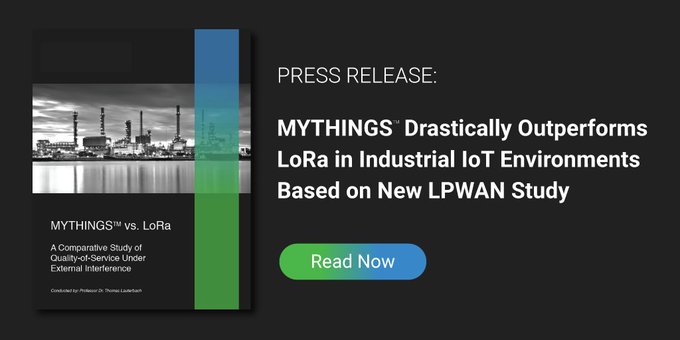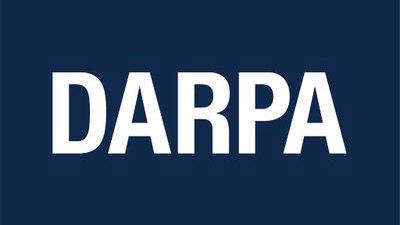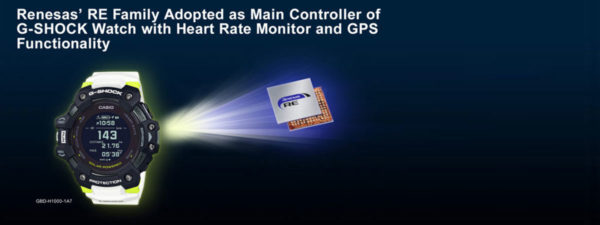BehrTech issued on Wednesday a report evaluating and comparing the quality-of-service of MYTHINGS and LoRa LPWAN under real-world interference conditions. Professor Dr. Thomas Lauterbach from the Nuremberg Institute of Technology conducted the independent study commissioned by BehrTech.
Results showed that in a real-world Industrial IoT environment with high levels of interference from other systems and devices, MYTHINGS has considerably higher interference resilience than LoRa. At the same network range, LoRa loses a significant percentage of messages while MYTHINGS transmits all messages.
The study has shown that not all LPWANs are created equal and network QoS under interference can vary from one technology to another. While MYTHINGS could zero out packet loss under heavy interference conditions, packet loss on the LoRa network remained considerably above the 1 percent permissible threshold. High PER signifies poor Quality of Service (QoS) and unpredictability in message reception.
In mission-critical IIoT applications, such a network can fail exactly when most needed. A solution purpose-built for interference resilience like MYTHINGS, provides users with a robust and future-proof IoT architecture that enables seamless network expansion, while guaranteeing optimal performance.
Using a LoRa EU-mode MultiConnect Conduit IoT Starter Kit and the EU-mode MYTHINGS by BehrTech Starter Kit, the study evaluated network performance over both a 60-minute period and a four-hour period under various external interference conditions based on the LPWAN Interference Model Standard developed by IEEE.

Results were measured by Packet Error Rate (PER), which refers to the percentage of unsuccessful message transmissions. Four interference scenarios were used to demonstrate different levels of signal density. The study focused on the dense level scenario which has an interference level equivalent to real-world Industrial IoT environments.
BehrTech offers a disruptive wireless connectivity software platform that is purpose-built for massive-scale industrial Internet of Things (IIoT) networks. At the core of the platform is MIOTY, a new communication technology standardized by ETSI that provides reliable, robust, and scalable connectivity unlike any other technology on the market.
BehrTech is the world-wide licensee of MIOTY developed by Fraunhofer Institute. With its approach to interoperability, BehrTech makes it easy for end users to retrofit its MYTHINGS platform in any environment and enables partners, system integrators, and VARs to deliver fully-integrated IIoT solutions that enable data-driven decisions to be made.
As wireless IoT deployments and radio traffic in the license-free sub-GHz bands rapidly grow, legacy LPWANs potentially come with serious QoS and scalability challenges caused by co-channel interference. Several mitigation mechanisms are available as add-on deployment options in the Medium Access Control (MAC) layer to reduce packet collisions and improve QoS in LPWAN.
One is the acknowledgment of received messages, in which a retransmission attempt is triggered if no packet acknowledgment is present. Another is the Listen-Before-Talk function wherein a node senses ongoing transmission in the radio environment before sending a message.
The problem with these mitigation mechanisms is their persistent trade-off on battery life. They introduce extra overhead communication head that considerably increases on-air time and power consumption of every message, not to mention higher complexity and cost of the transceiver design.
Adding acknowledgement also raises the chance of failed messages, since a transmitting base station cannot listen for incoming messages. As such, mitigation mechanisms are often bypassed in real-world LPWAN deployments, especially when long battery life is desired. In this context, Packet Error Rate becomes the key parameter to gauge QoS in LPWAN.
To accurately picture the difference in interference immunity among different LPWAN solutions, an impartial study has been conducted to evaluate the performance of MYTHINGS vs LoRa technology in the same IIoT-equivalent scenario.

As a widely adopted LPWAN solution, LoRa technology employs Chirp Spread Spectrum (CSS) modulation scheme that claims to provide robustness against interference and multipath conditions. On the other hand, MYTHINGS is an emerging wireless connectivity software platform that implements TS-UNB – a LPWAN technology recognized by ETSI for its interference resilience and scalability.
Both MYTHINGS and LoRa networks operate in the sub-GHz frequency bands and employ pure ALOHA – a lightweight asynchronous communication scheme. To ensure a fair comparison, in this study, the LoRa system is set to Spreading Factor 12 which offers the highest range and interference immunity.
“In the dense interference scenario, there was a significant difference in the quality-of-service between MYTHINGS and LoRa,” said Professor Dr. Thomas Lauterbach. “Observing both networks at the same signal power, MYTHINGS successfully delivered all messages while the LoRa network lost more than 10 percent of its messages. Even when signal power was increased, there was a four to five percent packet error rate in the LoRa system.”
“Data is the lifeblood of industrial IoT and with the ever-increasing number of connected devices in Industry 4.0, interference resilience is paramount to successful IoT deployments,” said Wolfgang Thieme, chief product officer at BehrTech. “MYTHINGS was purpose-built to withstand the significant interference that exists in industrial environments and to provide the robust and scalable future-proof connectivity needed for next-generation IoT networks.”
“Our research with other LPWAN technologies in Industrial IoT environments aligns with the results of the study,” said Amir Azhari, co-founder and COO at AOMS. “Other LPWAN technologies experience quality-of-service issues in demanding and harsh industrial IoT applications. Large campus sensors networks require a level of scalability which cannot be met with conventional LPWAN technologies due to the packet error rate and MYTHINGS is unique in that sense.”
“If I didn’t come across MYTHINGS, our company wouldn’t have started to develop industrial IoT solutions,” said Christian Leuchtenberg, CEO of Applied-IoT. “Our clients operate in harsh environments and we needed a reliable wireless solution that is robust and scalable. Our team has extensive experience in the LPWAN space and legacy technologies like LoRa do not meet these requirements.”




